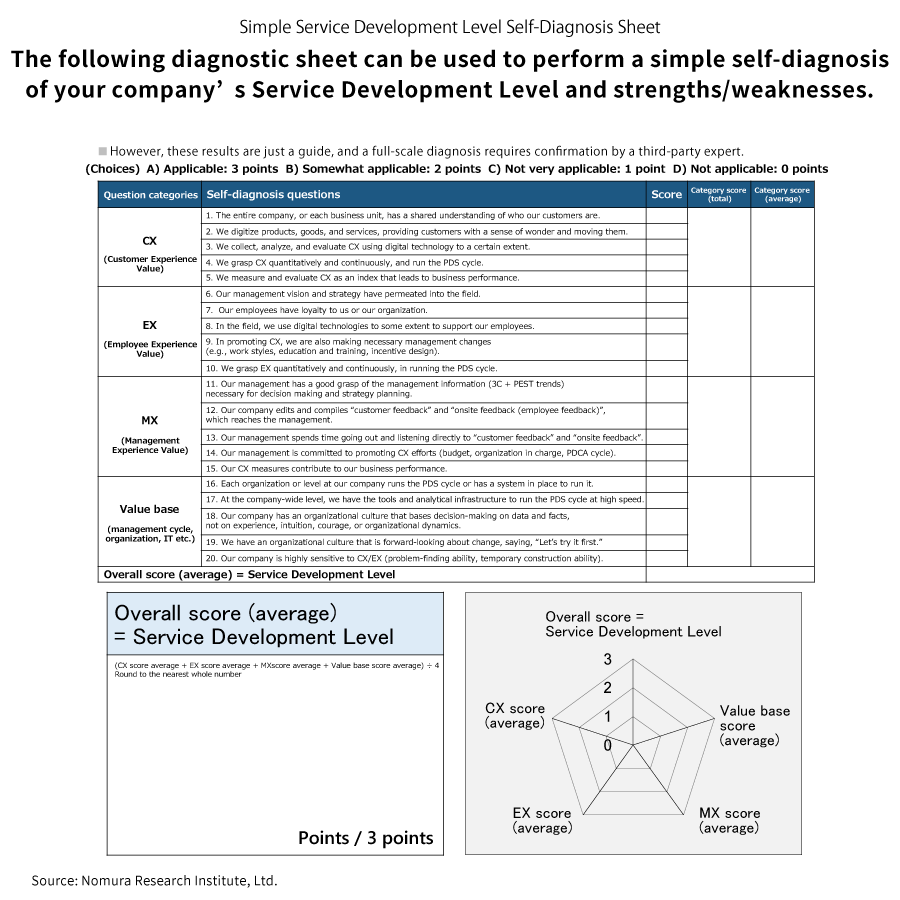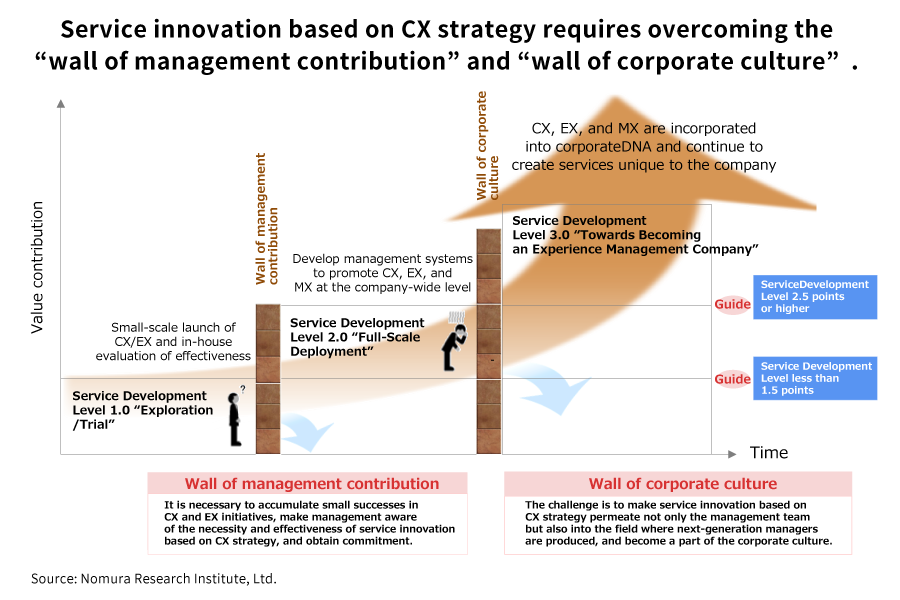
Service Innovation from Digital Technology--Through the Realization of High-Speed PDCA
The high-quality customer service of Japanese companies represented by the words “the customer is god” is supported by the bountiful experience and skills of excellent human resources. However, against the background of the labor shortage due to the declining birthrate and aging population, it is becoming difficult to sustain conventional customer service methods. To provide the same quality of service to all customers at all hubs, service standardization is inevitable. It could also be considered a necessary effort in striking out from the shrinking domestic market to overseas markets. One of the means to achieve this is service innovation using digital technology to accelerate the PDCA cycle and realize both customer satisfaction and employee satisfaction. We spoke with Masakuni Negishi of Nomura Research Institute (NRI), which has helped various client companies transform their business models using digital technology.
CX strategy-based service innovation
In recent years, the keyword “CX (Customer Experience: Customer Experience Value)” has been gaining currency in place of Customer Satisfaction (CS) as the starting point for service innovation. Previously, it has been tackled as a marketing measure on websites, but with IoT, AI, and other technological innovations, CX has expanded into real space.
Meanwhile, against the background of an intensifying labor shortage, the keyword “EX (Employee Experience: Employee Experience Value)”, which focuses on the employees who are the customer contact points for increasing CX, has also been attracting attention. This is because excellent human resources are said to gather in workplaces with high EX, demonstrate high performance, and continue work for a long time even after they become veterans. CX is improved alongside the enhancement of EX. To that end, it is necessary to create services not only from the front side of welcoming customers, but also from the perspective of employees on the back side.
Until now, the “C (Check)” part of the PDCA cycle, which is a continuous improvement method for things like quality control, sometimes did not work well because of the difficulty of tracking in the service sector. This is because evaluation of services and actions starting from analog hospitality has had to be done arbitrarily by store manager level employees and it is not possible to set standard times for different services according to the size and floor plan of each hub. However, these days, by utilizing AI cameras, sensors, and other IT devices, it is possible to acquire the status of service provision and consumption as data, and it is becoming possible to use PDCA for reviewing services.
At times like these, “MX (Management Experience: Management Experience Value)” is what is needed to strike a balance between CX and EX so that neither is overemphasized, and to prioritize from the perspective of overall optimization. In order to realize service innovation, management teams need to make appropriate decisions in light of customer feedback and on-site feedback.
Introduction of leading cases
There are now cases where companies have utilized digital technology to standardize things like evaluations and forecasts, which until now only some employees could do, and tie them to service innovation. Here are some of them.
Leading case 1 (Automation of employee behavior evaluation)
Company A is a call center agency business, where the evaluation of operator telephone conversations was performed by a person who listened to the recorded audio. Therefore, the evaluation side carried the challenge that experience and skills were required, and the number of conversations that could be evaluated was limited, so it was difficult to ensure the objectivity of evaluations.
Operator evaluations were automated by utilizing voice recognition and natural language processing technology using AI technology. Now conversation data can be converted into text, checked for compliance with the prescribed rules such as the use of words of gratitude, greetings, giving the operator’s name, repeating, and honorifics etc., and assigned a score emphasizing whether the customer’s request has been accurately understood.
Leading case 2 (High utilization of staff assignment tools)
Company B operates a leisure facility, characterized by the large fluctuation in the number of customers depending on the season and weather. As such, it introduced an IT tool for shift management called a “Labor Scheduling Program” (LSP).
As a result, it is now able to numerically grasp forecasted excesses and shortfalls in personnel for each time zone and assignment area, for which until now it had to rely on the experience value of store manager level employees, and to assign appropriate shifts in 15-minute increments.
Leading case 3 (Deployment of AI in nursing facilities)
Nursing facilities are suffering from chronic labor shortages, and the turnover rate for nurses has reached about 20%, roughly double the overall average of about 10% in Japan. Amid such circumstances, some efforts have been launched to utilize robots and digital technologies.
For example, there are cases where, in order to improve the level of nursing services and provide hints for improving the operational skills of staff members, AI cameras and deep learning are used to distinguish between good care and bad care and issue reports to staff members.
Service innovation starting from self-diagnosis tool
There are three major steps in the deployment of service innovation. “Service Development Level 1.0” seeks to explore a company’s own unique style; “Service Development Level 2.0” has accumulated achievements and is recognized to contribute to corporate profits; and “Service Development Level 3.0” continues to contribute to corporate profits. When taking on service innovation, the first thing you need to know is what stage your company is at in service development.
Therefore, we are introducing a “simple self-diagnosis tool” that can determine the service development level of your company. After answering all 20 questions in four categories, by calculating the average score for each category and the average score for all four categories (overall average score), it is possible to identify the service development level of your company and the strengths and weaknesses it has in different categories.
In this diagnosis, a company is considered to have attained “Service Development Level 1.0” if the overall average score is less than 1.5 out of 3 points; “Service Development Level 2.0” if it is 1.5 points or more and less than 2.5 points; and “Service Development Level 3.0” if it is 2.5 points or more.
-
(Note)
This diagnostic table is simple and concise so that a diagnosis can be made in a short time. Please consider it as a guide only. A full-scale diagnosis requires confirmation by a third-party expert.

“Service Development Level 1.0” is a stage where the need for service innovation is not understood by management. In this stage, CX and EX initiatives should be made at the field level. It is important to make efforts to accumulate small successes, make management aware of the necessity and effectiveness of such initiatives, and obtain commitment.
“Service Development 2.0” is a state in which management understands that on-site service innovation leads to corporate profits. What is important at this time is the formulation of medium-term strategies for the future and the creation of IT systems. Continuous service innovation aiming at the next step is required.
“Service Development Level 3.0” is a state in which management, promotion staff, and sites are organically linked, and CX, EX, and MX are functioning at the company-wide level. It requires a considerable amount of time and effort to reach this point, but only here will it be possible to create services that resist imitation.

There are many factors for realizing service innovation and making it work, and it cannot be realized overnight. Accompanying our clients along the way from small start trials, we at NRI hope to support management reforms that contribute to corporate profits, from CX-focused service innovation to system creation.
Profile
-
Masakuni Negishi
* Organization names and job titles may differ from the current version.